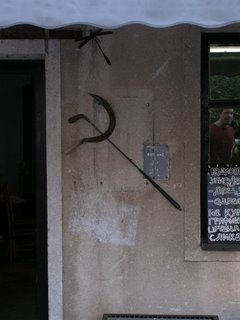Wednesday, August 02, 2006
Bled
I’ve always been under the impression that the Greeks were a hardy yet rough and unforgiving people. I remember reading another traveler’s account of a Greek shop owner ruthlessly berating a handicapped young man for crowding his retail space with a wheelchair. Our experience in Niki pretty much confirmed that generalization; people were friendly until they realized we might become the mildest sort of burden.
Since we were running short on time and interview fell through, we decided to forgo our trip to Bulgaria. I’m still a little down about that because it was one of the countries that I was looking forward to the most. Instead we took the train back to Belgrade for one night, and the next day on to Ljubljana.
To end our trip on a high note, we took a bus to Bled, Slovenia yesterday. The town is situated on a beautiful alpine lake near the Austrian border. For those of you that have seen Band of Brothers, it reminds me of the lake they are stationed on in the series finale. One of my favorite places on the trip.
We are headed back to Venice tonight, then London the next day, then Atlanta after that. Even though we are towards the end of our trip, stay tuned because, as we have learned, you never know what will happen next.
**For some reason I can't post photos under my account, so I've put the Bled photos in under Erica's in the post above.
Sunday, July 30, 2006
Last Days in Macedonia

Our next to last night in Macedonia did not go well for me. For the past year I have been taking an over-the-counter sleep aide called melatonin. Anyone who has ever lived with me knows that I am an insomniac. Melatonin has been a fairly effective sleep aide without the side effects of some of the other options. What I didn´t know was how dependent I had become on my magic sleeping pill. I ran out in Macedonia with no possibility for a replacement bottle, which resulted in me staring at the ceiling until 5:30 in the morning. I mention this to give you reference point for my state of mind over the next few days.
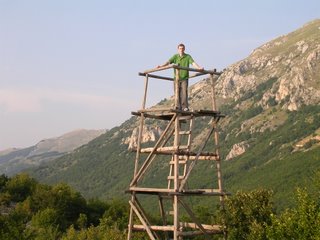
The following day we took an hour bus ride to the southwest corner of Lake Ohrid to one of Macedonia´s most famous churches, Sveti Naum. It is a beautiful area, bordered on one side by Lake Ohrid and on the other by a completely clear spring-fed lagoon. Dramatic mountains punctuate the backdrop. After having lunch at the monastary hotel, we decided to skip the next bus and check out the local national Park. Having had a good lunch we were feeling ambitious and decided we could walk the road up to one of scenic view points in the mountains. As with most of my excursion into the outdoors, the hike became a little epic; we spent the entire day hiking only to see the last bus going down the road while we were still a mile away. After standing around in the middle-of-nowhere Macedonia, in the dark, we started hiking to the next town. Luckily we managed to flag down a taxi headed back to Ohrid.
Tuesday, July 25, 2006
So, where are they now?
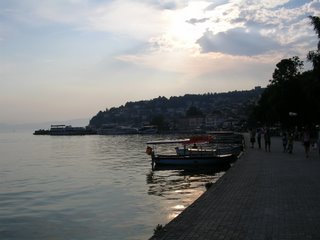
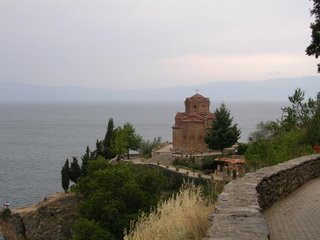
I’ve put up a couple of posts from Belgrade that we did not have the opportunity to upload. Hopefully we will be able to post at least once more before we leave Ohrid.
On War
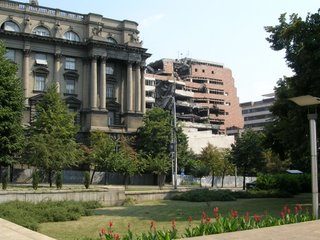
Am I bitter that the Serbs are displaying US service uniforms like they were Somalis dragging corpses around? No, not really. The people of Serbia, to lesser extent than the Bosnians, have been through hell in the last decade. The pain was mostly economic, as Milošević’s mismanagement of the economy led to record setting inflation. At its worst point, inflation of the Serbian Dinar reached 600,000% annually and 3% hourly (3% is a annual target rate for most countries). This resulted in the printing of bill with 11 zeros! (I’m looking for one of those on EBay when I get back). The NATO bombing campaign definitely destroyed some infrastructure but it is really more an issue of damaged pride and isolation from the west that Serbs cannot forgive.
Belgrade: A Second Look
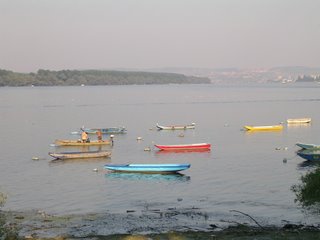
We had a much better time in Belgrade this time around. We have decided that our affinity for a city is usually determined by our lodging situation. The Belgrade Eye was a vast improvement over our last experience at The Three Black Cats, which was an apartment the size of ours turned into a smoke-filled filthy hostel. The Belgrade Eye was clean, spacious, and staffed by professional and helpful people.
On our second visit I discovered Belgrade’s charm that I overlooked on my first pass.
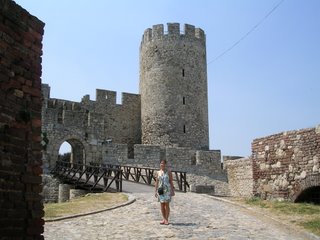
Kalemegdan is a massive layer cake of ancient fortresses on the bank of the Danube which has been ground zero for many dark pivotal events in history; Turkish Vizier Kara Mustapha was brought here to be strangled after he was defeated outside of Vienna and the first shots of World War I were fired at Kalemegdan from an Austrian battery on the opposite side of the river.
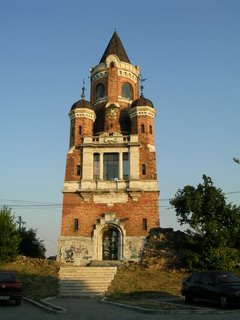
Zemun is located on the other side of the river and was once home to Belgrade’s Hapsburg overseers. The area still shows a stronger influence of Austrian architecture than central Belgrade.
Sunday, July 23, 2006
The path not chosen...
Tuesday, July 18, 2006
Back in Ljubljana
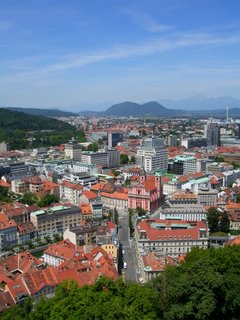 We are in Ljubljana, Slovenia and having a good time. Celica, our hostel, easily qualifies as the most unique and enjoyable of our lodging situations. It is a prison that has been converted into a hostel, art gallery, and restaurant. Rooms/Cells are reasonably priced and the food is an even better deal; for under $4 you can get a cheeseburger or chicken sandwich the size of your head. There is also live music every night. I'm using this down time to prep for some interviews in Belgrade later this week.
We are in Ljubljana, Slovenia and having a good time. Celica, our hostel, easily qualifies as the most unique and enjoyable of our lodging situations. It is a prison that has been converted into a hostel, art gallery, and restaurant. Rooms/Cells are reasonably priced and the food is an even better deal; for under $4 you can get a cheeseburger or chicken sandwich the size of your head. There is also live music every night. I'm using this down time to prep for some interviews in Belgrade later this week.
Milan
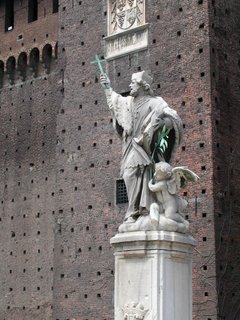
We took a night train from Bonn to Milan. We got some quality sleep and got to see quite a bit of the city. Milan has one of my favorite city parks of the trip!
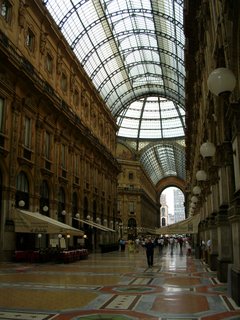
A big promenade in the old town.
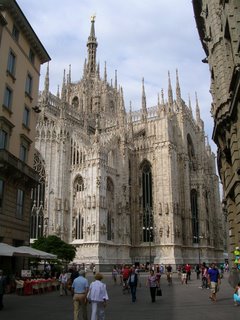
The 1,000th big cathederal I have seen on this trip.
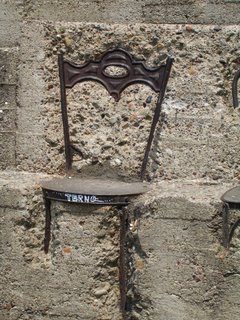
Some unique park furniture. You can tell when I have a good, cheap internet connection, can't you?
A few more TASA memories worth sharing...

Celebrating the 4th of July on a long bus ride. Jesse Cragwall pictured above, just making sure the non-Americans didn't forget what day it was.
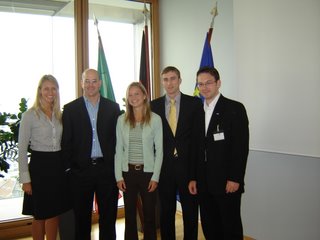
This is the UT Group. Fun Fact: The guy on the right once staged a mock crucifiction of himself to make street preachers in Knoxville mad. He says he wants to be a televangelist. Sigh....
Saturday, July 15, 2006
TASA ends
This post is dedicated to Tim and Jesse, without whom TASA would have been quite lame.
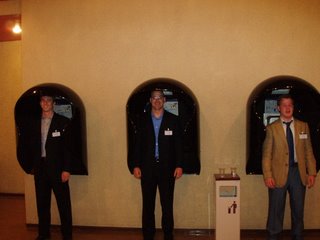
"Ludacris speed!!!" Spaceballs anyone? Anyone?
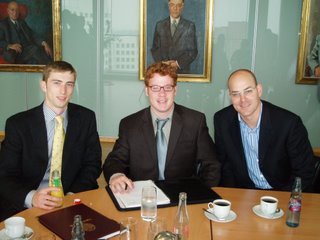
Sorry Tim.
Friday, July 14, 2006
It's the little things...
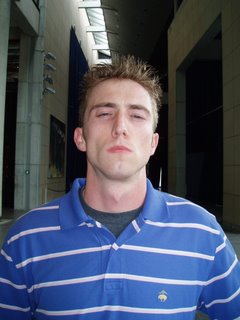
Wednesday, July 12, 2006
Sorry folks
Wednesday, July 05, 2006
Behind on the blogging...

I haven't had much time to blog about the day-to-day events of the TASA program, so I'm providing this link if you want a brief summary of the type of activities we are engaged in.
Also, I forgot to mention that we ran into 12 people from Knoxville in Strasbourg! They were in three different groups; one group was just some students visiting the city and the two others were there for the Tour de France.
Yes, I did...

The TASA group headed to Strasbourg today for a tour of the city and some other academic appointments. The city is really nice and historically interesting; however, I skipped out early because, by some lucky cosmic coincidence, the Tour de France was in town too! I found a spot inside the 1 kilometer mark and managed to snap a few photos. Watching a flat stage in person is anticlimactic, but it was awesome to be part of the energy that surrounds the race. To be honest, I’m not even sure who won the stage. I heard George Hincapie was in the lead, but I don't think he won the stage. By the time I made it down to the finish line they had already presented the yellow jersey.
 We are staying at a hotel across the German border in Lautenbach, a small town in the Black Forest. It’s a nice little stereotypical German town; all the hotel workers are fat German girls with rosey cheeks and blond pigtails. Too funny. Strasbourg is pictured above.
We are staying at a hotel across the German border in Lautenbach, a small town in the Black Forest. It’s a nice little stereotypical German town; all the hotel workers are fat German girls with rosey cheeks and blond pigtails. Too funny. Strasbourg is pictured above.
Thursday, June 29, 2006
Visit to Stasi headquarters

On Wednesday afternoon we visited the former headquarters of the East German security service, or Stasi. Our tour guide was an author who grew up in East Germany and whose father was arrested and imprisoned for not following close enough to the communist party line. The name (I can’t remember his name) found great irony and deep satisfaction in touring American students through the office of the former Stasi chief. He made a lot of quotable comments. For instance: “There is no such thing as peace in a dictatorship. Peace in such a place is merely a state of undeclared war on the state’s population. Therefore we should not argue against intervention on the basis of peace.”
Another Berlin post

On Tuesday, we started off our day with a visit to the German Institute for International and Security Affairs (expressed as the German acronym SWP), a think tank for German security issues. SWP is, however, very different from the American “think tank” concept because it receives funding from the federal government. SWP also has, theoretically, a direct line of influence to government officials that is unheard of in the US model. Is this a good thing? In this case, definitely no, but it might well explain why German foreign policy is usually amateur hour. The SWP representative that spoke to us blasted US foreign policy (expected) and said that all of Europe’s terrorism threats were caused by the US led war in Iraq. What is so absurd about this comment is that, though it may contain some truth, it ignores the glaring fact that France, Germany, and the UK have been sitting on a volcanic chain of unassimilated Muslim populations for the past 20 years. The Iraq war did not create an underclass of Islamic outcasts in Western Europe, the cultures and policies of those countries did. Even so, if the presenter had simply stopped there I wouldn’t have wanted to beat my head to unconsciousness on the table. But of course he didn’t. When pressed on the issue of intercepting terrorists abroad he said, “Well of course countries can catch terrorists abroad, but murdering them is unacceptable…blowing up suspected terrorist with missiles in Yemen is simply wrong.” I find this concept more than a little difficult to wrap my mind around; this clown wants us to send a diplomatic envoy to a country that doesn’t exercise effective control over 60 percent of its territory in the hopes that it will dispatch its ineffective and corrupt police force to arrest an admitted enemy of our country? I can discuss different policy options and perspectives with many different people with different opinions and backgrounds while keeping and open mind, however, I have no use for someone that does not see the value in a well placed HellFire missile from a Predator drone. So I decided to keep these thoughts to myself and I slipped into an intellectual coma, safe and out of the reach of the relativist black hole that had formed between his ears.
Perhaps this story provides a good opportunity to segue to an email question I received a couple of weeks back; Barrett wanted to know about the European reaction to Zarqawi’s death. I honestly didn’t find out until several days later and was informed by someone in Croatia who said, “Well, I guess your country finally managed to murder Zarqawi, huh?” I responded with a deadpan response of, “Interesting”, not really interested in the provocation. I’ve heard a few similar comments, but not many. The general feeling is that it won’t accomplish much. My take: My ethical response is best summarized by a quote from French philosopher Simone de Beauvoir, “Vengeance is pointless, but certain men did not have a place in the world we sought to construct.” My strategic evaluation of the situation is that he is replaceable but I doubt his successor will be as eager to stick his neck out. I also think that his death makes the reconciliation between Shiites and Sunnis much more plausible.
The photo is from the visit to the Bundestag the previous day.
Chancellery and Reichstag

On Tuesday we visited the German Chancellery and the Reichstag. A point of clarification from my point yesterday: The German parliament is building is still called the Reichstag while the law making body is referred to as the Bundestag. Both buildings are in a much more contemporary style than government buildings in D.C. Touring the Chancellery was strange because unlike a White House west wing tour, we pretty much had the entire building to ourselves. Very modern, kind of boring.
Sunday, June 25, 2006
So, what is it like being in Germany during the World Cup?
 Me and two other guys left the game early and went up into the Bundestag (or Reichstag, as it was once known). This is the German parliament building that the Nazis burned to the ground to consolidate their grip on the government. When Germany was reunited and Berlin was restored as the national capital, a modern dome was added to the top to symbolize unity and hope for the future. In the pictures I had previously seen in magazines, the dome always seemed most beautiful at night, so I was insistent on visiting it then. We were not disappointed. On top of the Bundestag there is a wide open square from which to view the city and the dome. The dome itself has two long interlocking corkscrew ramps - one for up-bound traffic and one for down – that never intersect. This creates a mind-bending effect as you ascend to the top observatory. At the top the dome there is an open skylight and a circular bench on which you can lay down and gaze heavenward. I’m usually pretty uninspired by modern architecture, but given the history of the spot – once a gravesite of democracy and the point of cleavage between East and West – only a clear break with the past could convey Germany’s hope for the future.
Me and two other guys left the game early and went up into the Bundestag (or Reichstag, as it was once known). This is the German parliament building that the Nazis burned to the ground to consolidate their grip on the government. When Germany was reunited and Berlin was restored as the national capital, a modern dome was added to the top to symbolize unity and hope for the future. In the pictures I had previously seen in magazines, the dome always seemed most beautiful at night, so I was insistent on visiting it then. We were not disappointed. On top of the Bundestag there is a wide open square from which to view the city and the dome. The dome itself has two long interlocking corkscrew ramps - one for up-bound traffic and one for down – that never intersect. This creates a mind-bending effect as you ascend to the top observatory. At the top the dome there is an open skylight and a circular bench on which you can lay down and gaze heavenward. I’m usually pretty uninspired by modern architecture, but given the history of the spot – once a gravesite of democracy and the point of cleavage between East and West – only a clear break with the past could convey Germany’s hope for the future.We went on a bus tour of Germany today and saw some interesting things; however, I fell asleep and missed a lot of sites. After a month of traveling, it takes a lot more to get me excited than it did earlier on the trip. Tour guide: “And over here is the Holocaust monument…” Me: “Oh wow. I guess I should take a picture of it. By the way, is reason we haven’t eaten yet part of some Holocaust sympathy experience?”
 Ever since visiting Sarajevo I’ve been thinking about how long it takes a city to recover from that level of destruction. Visiting Berlin is a clear warning not to be overly optimistic. There are quite a few buildings that are still tattered with bullet holes and if you look at the Greek Embassy on the West Berlin side, it looks like WWII ended yesterday, not 60 years ago.
Ever since visiting Sarajevo I’ve been thinking about how long it takes a city to recover from that level of destruction. Visiting Berlin is a clear warning not to be overly optimistic. There are quite a few buildings that are still tattered with bullet holes and if you look at the Greek Embassy on the West Berlin side, it looks like WWII ended yesterday, not 60 years ago.We also visited the Berlin wall. The attached picture is of me and fellow UT student Jesse Cragwal on the East German side. And, it is possible that the two youths pictured above might be in possession of pieces of said wall. The Gipper told us to.
Friday, June 23, 2006
So, what exactly is Matt doing in Germany?
I’ve really enjoyed our group so far. The Americans and the Canadians initially gravitated to each other because we are all (either by national stereotype or coincidence of individual personalities) all loud, extroverted, and talk really fast. Half the fun of hanging out with the Canadians is making fun of them. Best Canadian joke so far: “Canada is like a quiet apartment over a really cool party.”
This year’s TASA is culturally diverse; we have 3 Muslims participants who have made our discussions very interesting. We also have a few odd-balls. For instance there is a girl from Illinois with, what sounds to me like a Persian accent, but she is a 100% homegrown American. When pressed about this fact, she told us that she developed an accent while studying abroad a few years back. Umm…okay…We’re pretty sure she’s an Al-Qaeda spy.
Thursday, June 22, 2006
Missing three trains in 2 days turns Matt and Erica into homeless people
 So why have your intrepid travelers disappeared for the last few days? Well, we were booked on a night train from Belgrade to start our journey back to the comforts of western civilization; however, the train was 3 hours late. This put us in Ljubljana, Slovenia one hour too late to catch our train to Venice. The resulting five hour layover in Ljubljana was actually a very pleasant disruption to the itinerary, aside from the never-ending computations of exchange rates (Slovenia joined the EU in 2004 but has yet to switch currencies). Erica and I explored the city in shifts and were impressed enough that we plan to revisit while en-route back to the Balkans in July.
So why have your intrepid travelers disappeared for the last few days? Well, we were booked on a night train from Belgrade to start our journey back to the comforts of western civilization; however, the train was 3 hours late. This put us in Ljubljana, Slovenia one hour too late to catch our train to Venice. The resulting five hour layover in Ljubljana was actually a very pleasant disruption to the itinerary, aside from the never-ending computations of exchange rates (Slovenia joined the EU in 2004 but has yet to switch currencies). Erica and I explored the city in shifts and were impressed enough that we plan to revisit while en-route back to the Balkans in July.At this point, all would have been fine…if our train to Venice had showed on time. I must interject and say that I am utterly stupefied as to how trains can be so regularly late. It’s not like the engineer is lounging around at home watching the world cup drinking a beer and it suddenly dawns on him, “Oh crap!
 I’ve got to pick up two-hundred people in Belgrade tonight!” Or maybe it is. That would certainly explain a lot. I mean, I suppose occasionally a train obliterates a herd of cattle or a broken down Lada, and they have to clean the remains off the track. But that can’t happen everyday, can it? In any case, we arrived in Venice too late to catch the train to Milan or any destination closer to Germany. I knew that there was a night train leaving for Zurich in 2.5 hours, so I hoped we could grab a couchette on it. I also knew it was probably going to be booked and we would need a reservation. Unfortunately, when we arrived in Venice the international ticket office was closed and the self-service kiosks only worked for inter-Italy tickets. When the train did arrive I ran out to see if there was anything else. Nada. It was midnight and the next train was not until 7 the next morning. So Erica got the extra night in Venice she had wished for, with a twist. We slept in shifts on the steps of the Venice train station.
I’ve got to pick up two-hundred people in Belgrade tonight!” Or maybe it is. That would certainly explain a lot. I mean, I suppose occasionally a train obliterates a herd of cattle or a broken down Lada, and they have to clean the remains off the track. But that can’t happen everyday, can it? In any case, we arrived in Venice too late to catch the train to Milan or any destination closer to Germany. I knew that there was a night train leaving for Zurich in 2.5 hours, so I hoped we could grab a couchette on it. I also knew it was probably going to be booked and we would need a reservation. Unfortunately, when we arrived in Venice the international ticket office was closed and the self-service kiosks only worked for inter-Italy tickets. When the train did arrive I ran out to see if there was anything else. Nada. It was midnight and the next train was not until 7 the next morning. So Erica got the extra night in Venice she had wished for, with a twist. We slept in shifts on the steps of the Venice train station. It was kind of like the story of the monkey-paw that you wish on only to have an evil version of your wish come true. I slept one and a half hours, Erica managed 2. At around 5 AM, the train station opened and we got inside where it was warmer and I caught another few minutes of sleep. Luckily for us we were up and awake before the security guards starting harassing the other bums. During the course of the night, a homeless lady that had begged us for money in our first visit came and laid down near us. When she never asked us for money I realized it was because we had joined her social class.
It was kind of like the story of the monkey-paw that you wish on only to have an evil version of your wish come true. I slept one and a half hours, Erica managed 2. At around 5 AM, the train station opened and we got inside where it was warmer and I caught another few minutes of sleep. Luckily for us we were up and awake before the security guards starting harassing the other bums. During the course of the night, a homeless lady that had begged us for money in our first visit came and laid down near us. When she never asked us for money I realized it was because we had joined her social class. On the train the next day we were disgustingly filthy and hungry. We had money for food but, almost everywhere we went was closed. After spending eight hours as pariahs on the train, we finally arrived in Lucerne. What’s Lucerne like? I don’t really know. We walked briefly and took some pictures. It looked really nice, but all we wanted was a shower and food. We arrived at 4:00 and went to bed at 8:30. Being back in the fluffy creature comforts of western culture has a rejuvenating effect. The tiny $80 hotel room we had last night might as well have been the Four Seasons.
On the train the next day we were disgustingly filthy and hungry. We had money for food but, almost everywhere we went was closed. After spending eight hours as pariahs on the train, we finally arrived in Lucerne. What’s Lucerne like? I don’t really know. We walked briefly and took some pictures. It looked really nice, but all we wanted was a shower and food. We arrived at 4:00 and went to bed at 8:30. Being back in the fluffy creature comforts of western culture has a rejuvenating effect. The tiny $80 hotel room we had last night might as well have been the Four Seasons.I’m writing this on the train to Bonn, where I am attending this year’s Transatlantic Summer Academy for three and a-half weeks. I’m racing a dying battery, so I’ll have to end this post here. But I will end this post by saying that we are now clean, fed, and almost rested.
Serbia
 I was a little apprehensive about visiting Serbia because of lingering anti-Americanism from the U.S. bombing campaigns in 1995 and 1999. Before the trip, every person knowledgeable of the area assuaged my concerns and encouraged me to visit. They were correct, though the anti-American sentiment is noticeable, it is not overt. In fact a lot of what I initially interpreted as an anti-American vibe was, as I later discovered, is really just part of a general xenophobia. It turns out that, in contrast to their forefathers, very few Serbians (less than 15%) have visited the West.
I was a little apprehensive about visiting Serbia because of lingering anti-Americanism from the U.S. bombing campaigns in 1995 and 1999. Before the trip, every person knowledgeable of the area assuaged my concerns and encouraged me to visit. They were correct, though the anti-American sentiment is noticeable, it is not overt. In fact a lot of what I initially interpreted as an anti-American vibe was, as I later discovered, is really just part of a general xenophobia. It turns out that, in contrast to their forefathers, very few Serbians (less than 15%) have visited the West.The Socialist Republic of Yugoslavia was the most economically successful of all the socialist bloc countries. When Stalin and Tito split in the 1950s, Yugoslavia needed to strengthen Western ties to discourage a Soviet invasion. The result was a communist country liberally engaged in trade with Western economies. Whatever prosperity had been accrued the following decades was obliterated by Milosovic’s maniacal mismanagement of the economy in the 1990s. In an eight year period 30 -40 percent of Serbia’s economy disappeared. Though Belgrade is today a modern and thriving metropolis, the results of the economic collapse can be seen in the large shanty-towns that appear along interstate overpasses on the city’s outskirts.
The most important interview of my trip was supposed to be here and I had planned the entire first half of our trip around his schedule. I called on our first day in Belgrade only to find out that we would be gone the entire week. However, the two consolation interviews, which turned into a 4.5 hour intellectual marathon, were extremely helpful.
 The second interview was with the institution’s V.P., who is a western educated Bulgarian. We spent about two hours talking about my thesis specific questions, and another 1.5 talking about Balkan history. He, like many people who are erudite in their knowledge of the region, insists that you cannot understand any of the modern Balkan problems without viewing it through the lens of history. Unlike one of my earlier interviewees, this guy had no concerns over anonymity, though he made much more inflammatory statements. When I asked about the EU suspending candidacy talks with Serbia and what could motivate reform given this withdrawal, he responded very directly, “What Serbia needs is a second bombing campaign…and after that probably a third. I believe that is the only way they will ever wake up and realize that it is 2006 and that fighting over some hill because something happened 600 years ago is ridiculous.” To me, that was a shocking statement, given his position, the location of his office, and the fact that there five Serbian intelligence agencies. However, I’m sure he understands the delicacies of his situation better than I.
The second interview was with the institution’s V.P., who is a western educated Bulgarian. We spent about two hours talking about my thesis specific questions, and another 1.5 talking about Balkan history. He, like many people who are erudite in their knowledge of the region, insists that you cannot understand any of the modern Balkan problems without viewing it through the lens of history. Unlike one of my earlier interviewees, this guy had no concerns over anonymity, though he made much more inflammatory statements. When I asked about the EU suspending candidacy talks with Serbia and what could motivate reform given this withdrawal, he responded very directly, “What Serbia needs is a second bombing campaign…and after that probably a third. I believe that is the only way they will ever wake up and realize that it is 2006 and that fighting over some hill because something happened 600 years ago is ridiculous.” To me, that was a shocking statement, given his position, the location of his office, and the fact that there five Serbian intelligence agencies. However, I’m sure he understands the delicacies of his situation better than I.We will be returning in July, at which time I have two more interviews with staff members there. Tomorrow we are headed somewhere west and closer to Germany. I’m getting tired of Belgrade and especially tired of our “hostel”.
Final notes on Sarajevo
Unlike other places we have visited in the Balkans people open, friendly, and rarely suspicious. Even in Croatia, westerners attract a lot of cautious gawking. In Sarajevo (and for that matter all the
 places we stopped in Bosnia) foreigners are only casually noticed. I got the feeling that whether you walked down the street in an Armani suit, t-shirt and shorts, or a kimono, no one would give you a second look.
places we stopped in Bosnia) foreigners are only casually noticed. I got the feeling that whether you walked down the street in an Armani suit, t-shirt and shorts, or a kimono, no one would give you a second look.On our last full day in Sarajevo, we visited the 800 meter tunnel that the Army of Bosnia and Herzegovina constructed to save the city’s population when it was under siege by the Serb army and denied protection by the UN. Through this tiny tunnel passed all the electricity, petroleum, food, and weapons that the citizens had to survive. The UN controlled the airport, but only provided food and would turn back anyone who they caught crossing into free Bosnia. One of the tunnels former users said, “We lived every moment with the fear of being killed, but all the UN cared about was whether we were well-fed when we died.” About 11,000 people died in the siege of Sarajevo.
Wednesday, June 21, 2006
Tuesday, June 13, 2006
 This is a picture of me standing in the exact spot that Gavrilo Princip did on June 28, 1914 as he shot and killed Austro-Hungarian Arch Duke Franz Ferdinand and his wife Sofia. This event was the flash point that began the First World War. Amazing!
This is a picture of me standing in the exact spot that Gavrilo Princip did on June 28, 1914 as he shot and killed Austro-Hungarian Arch Duke Franz Ferdinand and his wife Sofia. This event was the flash point that began the First World War. Amazing!We have posted some pics that were previously missing aslo. Enjoy!
We are off to Belgrade tomorrow morning.
…Into Bosnia

“I hate the corpses of empires, they stink as nothing else. They stink so badly that I cannot believe that even in life they were healthy.” - Rebecca West in her 1940 masterpiece Black Lamb and Grey Falcon: A Journey Through
The first real signs of war damage we saw today began about 30 miles outside of the Bosnian town of
 Fortunately, the next hour of the drive erased a lot of the unpleasantness of Mostar. The road between Mostar and
Fortunately, the next hour of the drive erased a lot of the unpleasantness of Mostar. The road between Mostar and
 As the Death March wore on into the old town,
As the Death March wore on into the old town,
 It’s
It’s
Out of Eden...
Travel adventures, like the rest of life, are rollercoaster rides of emotion. After three great days in
Monday, June 12, 2006
Changes to the Comments section...
We are in Sarajevo now but will not be able to post something until tomorrow. It's going to be a good one, so tune in.
Sunday, June 11, 2006
Technical difficulties...
Some Notes on Croatia and Dubrovnik
Another important area of progress is obvious in Croatia’s law enforcement. Unlike the scowling ex-Red Army extortionist that typifies the Ukrainian law enforcement official, Croatian police are generally young, smiling, professionally dressed, and progressively courteous. Unlike their Ukrainian counterparts, you don’t have to avoid making eye contact with them. In Ukraine, if I was the victim of some crime, I would never consider going to the local police station – first stop, American Embassy. But here the rule of law, though not developed to Western standards, seems trustworthy. In my interview the other day I learned that Croatia has no division of its courts and there are currently 2.21 million unresolved cases, so there is certainly room for improvement. At least there is a place to start, further east, in places like Ukraine, they have much more dire need than judicial reform.
Dubrovnik
Dubrovnik is a medieval castle version of Venice. Thought Dubrovnik cannot compete with Venice on the playing field of culture, it is founded on some aesthetic qualities which Venice lacks. A 2,000 ft mountain curls dramatically down to the city’s back gate, while the city wall itself is built around a steep hill that slumps into the Adriatic. The effect this has, aside from stair climbing exhaustion, is a series of vistas that Venice is poorly geographically endowed to match. Unlike Venice, Dubrovnik is monotone; the entire city remains true to its bleached stone block foundation. This would look bland if it were not encased by the greens of surrounding mountains and the deep clear blues of the Adriatic.
Dubrovnik was once a very powerful force in history. It was known worldwide as the gateway port to the East, where goods could be shipped over land to Constantinople. Dubrovnik, unlike the rest of the Dalmatian Coast, never succumbed to the Venetian expansion. Through shrewd diplomacy, it also (and improbably) held both the Hungarians and Ottomans at bay. Staunchly Catholic, Dubrovnik held key alliances with Spain which sustained it in many dark hours of history.
 Given Dubrovnik’s history of independence and physical isolation from the rest of Croatia, I was surprised at the level of Croat nationalism on display; Croat flags are on most buildings, t-shirts, hats, cars, etc.,. However, Dubrovnik has been the victim of fairly recent trauma which is responsible for these visible sentiments. In the 1990’s conflict, Dubrovnik was shelled by Serbian and Montenegrin artillery and the city was blockaded for a number of months. As a result, roughly 100 residents lost their lives. Certain portions of the city have not been reconstructed, I assume intentionally, as a living reminder of Serbian aggression. In light of these facts, I think the level of Croatian nationalism on display is really just an expression of anti-Serb and Montenegrin sentiment, but they don’t really make a flag for that.
Given Dubrovnik’s history of independence and physical isolation from the rest of Croatia, I was surprised at the level of Croat nationalism on display; Croat flags are on most buildings, t-shirts, hats, cars, etc.,. However, Dubrovnik has been the victim of fairly recent trauma which is responsible for these visible sentiments. In the 1990’s conflict, Dubrovnik was shelled by Serbian and Montenegrin artillery and the city was blockaded for a number of months. As a result, roughly 100 residents lost their lives. Certain portions of the city have not been reconstructed, I assume intentionally, as a living reminder of Serbian aggression. In light of these facts, I think the level of Croatian nationalism on display is really just an expression of anti-Serb and Montenegrin sentiment, but they don’t really make a flag for that. My best description of Dubrovnik today is a Greek version of Venice. I say Greek because that was the ethnicity of the original settlers. Despite the recent the superficial Croat nationalism, Greek faces and mannerisms shine through. It has been a nice place to relax and regroup before heading into Bosnia.
Saturday, June 10, 2006
To Dubrovnik
Our train arrived in Split a few minutes before 7:00 AM with us slightly rested. Getting to Dubrovnik is not a simple task; it is isolated on a narrow strip of land separated from the rest of the nation by a little slip of Bosnia and Herzegovina which interrupts the Croatian coastline near Ploče. Due to the 1990’s conflict and logistical problems, there is no direct rail connection. From Split, the southern most rail stop, the only choices available are either a day and a half ferry ride or a five hour bus ride. We got two bus tickets $40 and got rolling by 8:00.
Now, of the many archetypes of people that have started to annoy me on this trip, I think the know-it-all-hippie-backpacker (henceforth KIAHB) is currently at the top of my list. When we bought our tickets the cashier made it a point of telling us what seats we had been assigned, and I requested seats on what would be the east-facing side of the bus because I knew it would have a better view. As we boarded the bus a young Croatian guy was sitting in one of our seats. Erica politely asked him to move, but as he started to politely comply the KIAHB comes toward us and says smugly, “Umm…I hate to break it to you guys but this is C-R-O-A-T-I-A and reservations don’t happen here.” My response, “Well, they just did”. Seriously, if I have to deal with many more KIAHBs I’m going to decapitate one and parade his/her head around on a stick so that all KIAHBs will know to maintain a respectful distance…preferably at least one time zone.
The bus was ok, the scenery was incredible (PCH eat your heart out), but everything else about the ride sucked. Croatian roads are better than Ukrainian roads, but not much. The highway was a bumpy corkscrew path through the mountains along the coast. All the ancillary motion pretty much ruled out reading, writing, or thinking, and since I had left my IPOD in my backpack under the bus, I was subjected to the World Cup Dance Mix, which included The Macarena. Despite that every time I hear The Macarena I have a barely-resistible urge to jump out the window into oncoming traffic, I have decided that it contains the secret to world peace. I’m pretty sure every country in the world loves this song…which may also explain why the human race hasn’t been smart enough to figure out world peace.
The Macarena, sleep deprivation, KIAHBs, the sun-baked 3-day-old goat cheese pastry I had for breakfast, and tilt-a-whirl bus ride were making me really nauseous. But it was only when the ticket collector came by, carrying what I can only describe as the second generation of the abacus, that I almost threw up. It was his smell that almost got me. Actually the mix of two smells. Given the correct environmental surrounding and a temporary lapse in hygiene, people give off an odor that my brain interprets as a really pungent version of Cambell’s Chicken-Noodle Soup. Though, its not one of my favorite smells, this aroma did do me in alone. The second smell, also not physically revolting alone, was a liberally applied veneer of Old Spice. From about 7 feet away his signature flavour was wafting my direction and I could feel my face turning green. When he lingered next to my seat to re-calibrate the gears of his Abacus 2.0 ticket counter, I had put myself into a deep zen-like state to keep from covering his shoes in half-digested goat cheese pastry. I succeeded, which was good because he was a really nice guy.
Friday, June 09, 2006
Research Begins
Most of the info I got from the interviewee was not truly citable since the juiciest stuff relied on hearsay and he certainly wasn’t willing to have his name next to it. However, all these tidbits and the wealth of contact information he provided were extremely helpful. His steadfast protection of his opinions and sensitive information was due the delicate relationship he has to maintain with the Croatian government. Having the wrong thing put into print could cause serious damage to his work.
Tonight we are headed to Split, Croatia by train. From where we will head to Dubrovnik (and the ocean) if all goes as planned. I really don’t know if we’ll be in Split, Dubrovnik, or in between tomorrow night. I have no idea if we will be able to post in the next few days, but hopefully if we do it will be pictures of sun and sand.
P.S. I’m watching the Croatian version of “Who Wants to be a Millionaire?” and the Croatian Regis is hilarious.
P.P.S. The Ravnice Youth Hostel is great! If you ever find yourself in Zagreb and need a cheap fun place to stay, do yourself a favor and stay here. However, make sure and avoid rooms with snoring Scottish girls.
Thursday, June 08, 2006
Destination Balkanization
 they spoke Russian. I finally got one woman talking and she gave me some tram info in Russian (or in Croatian and I just understood her, I’m not sure which because it sounded funny). But when I followed up by asking how much it cost, she said she didn’t know. At this response I started to get pretty angry. I asked her how long she had lived in Zagreb, she replied "always". I told her I couldn’t believe she didn’t know how much it cost. She told me to go away. As it turned out, she wasn’t lying; the tram does cost money but no one buys tickets. Evidently no one ever checks tickets so no one buys them. Of course it took a while longer to figure this out.
they spoke Russian. I finally got one woman talking and she gave me some tram info in Russian (or in Croatian and I just understood her, I’m not sure which because it sounded funny). But when I followed up by asking how much it cost, she said she didn’t know. At this response I started to get pretty angry. I asked her how long she had lived in Zagreb, she replied "always". I told her I couldn’t believe she didn’t know how much it cost. She told me to go away. As it turned out, she wasn’t lying; the tram does cost money but no one buys tickets. Evidently no one ever checks tickets so no one buys them. Of course it took a while longer to figure this out.My next stop was an ATM to get some local currency; my Euros had already been turned down twice which surprised me. Just a year or two ago all of the former Yugoslavia was Euro-hungry, but apparently the economy is booming with a resurgence in tourism and business investment related to Croatia’s eminent EU membership. The problem with my ATM search was that I could not remember the exchange rate. So looking at a screen filled with withdrawal choices of large numbers of Kuna, I had to text-message my Mom to get her to look up the exchange rate. (Now you know why, mom).
I returned to the train station to find Erica in conversation with a drunk (and getting drunker) Croatian guy ("I am not a Croatian, I have German heritage.") The rest of the time went as you would expect in Eastern Europe; drunk Croatian ("No! I am a German!") hitting on my wife, showing us photos from semi-pornographic magazines, quoting American action movies, reciting the lyrics to Duran Duran songs and repeatedly giving me copies of early 1990s Croatian sports magazines, which he insisted were collectors items.

The best place I have been to base a comparison of Zagreb off of is Kiev. The first and most obvious impression is that Zagreb has not experienced the level oligarchial theft that has destroyed any hopes of economic equality in the Ukraine; here, wealth is somewhat more modest (Mercedes for the rich instead of Bentleys and Rolls) and there is a lot of middle class construction going on. Zagreb is a slightly charming though not exciting city, but it is trying to capitalize off the Dalmatian Coast tourism boom. All this said, there are still many people that have obviously been left behind by the new economy and will suffer at its expense, as is the case in all transforming, post-communist countries. Furthermore, although many business people and government officials are enthusiastic about integrating with Europe (most gov’t buildings already display EU flags), I think there remains among the general population, an acute xenophobia that will impede any chance of cultural assimilation. Communism, or more precisely in this case Titoism, leaves a long and painful scar that is not easily excised.
Wednesday, June 07, 2006
Last day in Venice
After spending the entire day beating the streets of Venice, we had decided by default to take the night train to Zagreb. We booked a couchette which is supposed to house six beds in cramped quarters. Luckily, the train was near empty and we had the room all to ourselves. Now, I admit there was one naïve moment where I thought I would be able to catch some quality sleep…lesson quickly and thoroughly learned. The train was servicing Venice to Budapest, Hungary, and I quickly realized that they were not calling out stops. Most of my night was filled with nightmares of waking up to a Hungarian customs official 600 miles past my destination. The other constant interruptions to peaceful slumber were the actual customs officials. Erica and I were both sleeping with our IPods on to drown out the drunks in the next car, however, this also drowned out a very frustrated customs officer at the Slovenian border. Now the next four customs officials to knock on our door are still a source of confusion to me; being a geographer, I was relatively certain that there were no countries between Slovenia and Croatia. I still hold this conviction, however, we had three extra visits by customs officers and illegible passport stamps to match.
Tuesday, June 06, 2006
No, he didn't!
Monday, June 05, 2006
Venezia
 Unlike the fairytale land of Venice, the reality is in fact brittle, perpetually rundown, and sinking into the ocean. No cars. No buses. No subway. Its transportation network, made entirely of claustrophobia inducing pedestrian alleyways and constricted canals, is virtually un-navigable with rarely anything resembling a thoroughfare. Case in point, the straight-line distance from our hotel to San Marco is less than one mile, however, the most direct route requires roughly 30 turns to arrive! Add to this the fact that there are almost no vantage points from which you can gain your bearing and you realize Venice is actually a 1,600 year old maze. Also incredibly crowded: Venice is only 7.6 km², yet has a population of roughly 275,000 and is assailed by some 6 million photo snapping tourists per year! That’s like all of Knoxville and Maryville living on UT’s campus with all of the Smokey’s visitors coming to visit. With all these crowds there must be an incredible level of public services right? Wrong. Want to find a trashcan or bathroom? More precious and rare than Venetian glass; you’ll have to hold it, whichever it is. So given all the grittiness and dysfunction of Venice, would I live here? In a heartbeat.
Unlike the fairytale land of Venice, the reality is in fact brittle, perpetually rundown, and sinking into the ocean. No cars. No buses. No subway. Its transportation network, made entirely of claustrophobia inducing pedestrian alleyways and constricted canals, is virtually un-navigable with rarely anything resembling a thoroughfare. Case in point, the straight-line distance from our hotel to San Marco is less than one mile, however, the most direct route requires roughly 30 turns to arrive! Add to this the fact that there are almost no vantage points from which you can gain your bearing and you realize Venice is actually a 1,600 year old maze. Also incredibly crowded: Venice is only 7.6 km², yet has a population of roughly 275,000 and is assailed by some 6 million photo snapping tourists per year! That’s like all of Knoxville and Maryville living on UT’s campus with all of the Smokey’s visitors coming to visit. With all these crowds there must be an incredible level of public services right? Wrong. Want to find a trashcan or bathroom? More precious and rare than Venetian glass; you’ll have to hold it, whichever it is. So given all the grittiness and dysfunction of Venice, would I live here? In a heartbeat. My true take on Venice: Utterly. Amazing. City. Honestly, no other place I have visited gives me any basis for comparison. Venice is really more of a Renaissance theme park than a city. The most amazing aspect of the island is its continuity of style; every bridge, alley, street, and apartment is picturesque. There is nowhere you can turn and not know you are in Venice. The Venetian look has not been achieved in the American sense of city planning; it is really just a hodgepodge unplanned and understated local style thrust together and topped off with the occasional grandiose Byzantine, Roman, Renaissance, or Baroque exclamation point. The Venetian Miracle is really that a sense of continuity prevails through a millennia and a half of chaos.
My true take on Venice: Utterly. Amazing. City. Honestly, no other place I have visited gives me any basis for comparison. Venice is really more of a Renaissance theme park than a city. The most amazing aspect of the island is its continuity of style; every bridge, alley, street, and apartment is picturesque. There is nowhere you can turn and not know you are in Venice. The Venetian look has not been achieved in the American sense of city planning; it is really just a hodgepodge unplanned and understated local style thrust together and topped off with the occasional grandiose Byzantine, Roman, Renaissance, or Baroque exclamation point. The Venetian Miracle is really that a sense of continuity prevails through a millennia and a half of chaos.Quick facts:
Oldest church – San Giacomo di Rialto, built in 427 A.D.
The Basilica San Marco was built in 1094 and is the third church to be built on the site.
The Santa Maria della Salute was built in the mid 1600s, fulfilling a promise to construct a church if God would end the plague which had killed off a third of Venice.
Leaving London
The rest of the day was spent in a hectic and, once again, expensive rush back to Gatwick Airport. A Saturday evening, the airport was dead. Our flight to Venice was only two hours long and completely uneventful.
P.S. For some reason I can't post photos right now...I'll go back and add them later.
Saturday, June 03, 2006
So it begins...
So, the journey has officially begun! On the plane I was thinking about kicking off this first post with some poetic reference to the explorer Magellan and his voyage around the world, but then I remembered that Magellan did not actually survive that little boat trip, a little known fact that makes for an unfortunate metaphor.
 From the Globe we walked to the
From the Globe we walked to the
Well, I’m going to doze off again to the soothing sounds of Euro techno thumping through the wall from the bar two rooms away. Tomorrow night,

